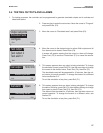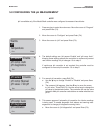
MODEL 54eA SECTION 5.0
SOFTWARE CONFIGURATION
5.7 CHANGING ALARM PARAMETERS (continued)
9. Alarm setup for TPC alarms:
a. Move the cursor to the desired alarm setup and press Enter (F4).
b. Use the and keys to move the cursor to the desired param-
eter. Press Edit (F4). Use the arrow keys to change the setting to
the desired value and press Save (F4) to store the value
Setpoint: Setpoint is the usually the value to which the process
is to be controlled. The alarm will not be on much when the
process is at the setpoint value.
Proportional: Proportional is the same as proportional band and
is the range over which control is being used. It is the opposite of
process gain. Smaller values provide tighter control.
Integral: Integral is the number of seconds over which deviations
from the setpoint are integrated to remove continuing offsets.
Smaller values provide higher response.
Derivative: Derivative is a form of control that resists all changes
in readings. Higher readings increase the derivative function. To
prevent process oscillation, use caution in setting the derivative
value.
Time period: Time period is the cycle time for TPC control. One
cycle consists of an energized (relay on) time and a deenergized
(relay off) time.
URV: URV is the deviation from the setpoint that results in the
alarm being on all the time.
LRV: LRV is the deviation from the setpoint that results in the
alarm being off all the time. The LRV should be set to 0.00.
Setpoint : 1.000 ppm
Proportional: 100.0%
Integral: 0 sec
Exit Edit
Alarm 1 control
Alarm 1 setup
Alarm 2 control
Exit Enter
FIGURE 5-2. Low Alarm FIGURE 5-3. High Alarm
35


















